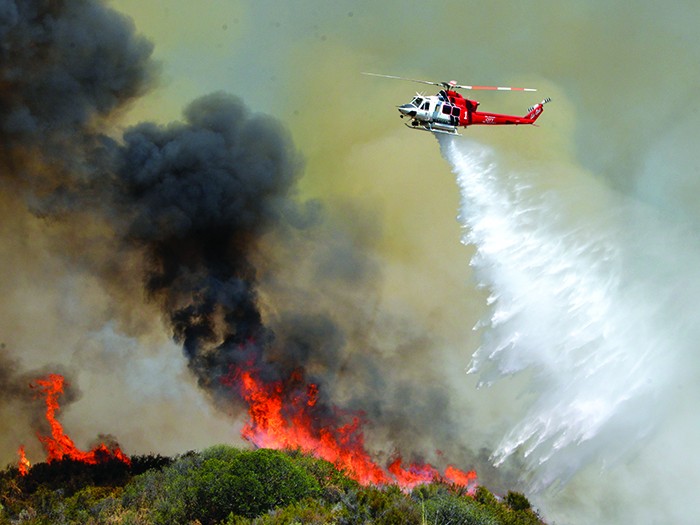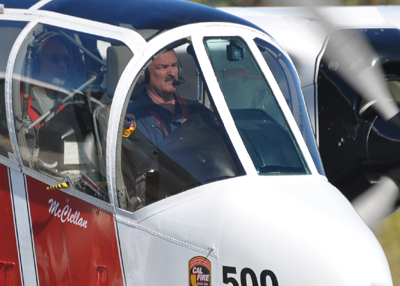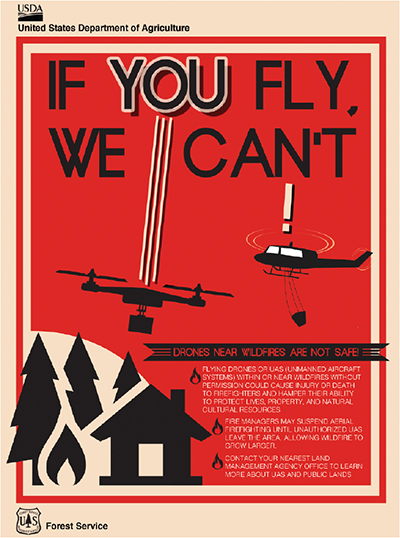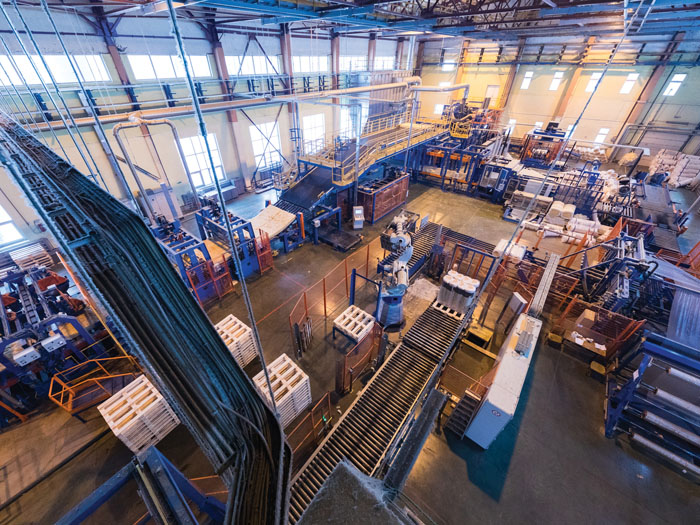Evolving Risk
Rogue Drones

This summer, at one of California’s numerous wildfires, the appearance of a drone over Interstate 15 forced firefighting aircraft to back off for about 20 minutes until it flew away.
Instead of 40 or 50 acres burning before that fire was controlled, a few thousand acres, along with about 20 vehicles, were destroyed, as drivers ran from the area, according to reports.
In July alone, there were about a half-dozen similar incidents in California. Anywhere from two to five drones appeared at fire sites, sometimes chasing after the air tankers and helicopters, and forcing the aircraft to delay dropping retardant or even calling off operations until the areas could be cleared.

Dennis Brown, chief of flight operations, California Department of Forestry and Fire Protection (Cal Fire)
“It has hampered our efforts,” said Dennis Brown, chief of flight operations at the California Department of Forestry and Fire Protection (Cal Fire), which has about 50 air tankers and helicopters that respond nearly daily to wildfires from March through November.
“The size of the drones, even though they look small, could cause significant damage to any of our aircraft,” Brown said. The tail rotor of a helicopter is particularly vulnerable and a tail rotor strike could be catastrophic. “We had one helicopter pilot coming in to land to drop off a crew and there was a near miss by a drone,” he said. “It was 20 to 30 feet away, right in the windscreen.”
Sometimes, the drones are operated by homeowners checking for damage to their property. Sometimes it’s just curiosity or a desire to photograph the scene and post it to social media that prompts the drone operators.
“The size of the drones, even though they look small, could cause significant damage to any of our aircraft.” — Dennis Brown, chief of flight operations, California Department of Forestry and Fire Protection (Cal Fire)
But regardless of the reason, interference from drone operators is obstructing firefighting efforts and increasing danger to the pilots and their aircraft.
“The pilots are flying low and they are flying fast,” said John Glenn, chief of fire operations for the Bureau of Land Management. “There are a lot of hazards there. You throw drones or UAVs into the mix and there have been a number of cases where we have shut down operations until we can clear the air.”
Open Season for Drones
Public safety hazards due to drones aren’t limited to firefighting. The Federal Aviation Administration reports about two dozen drone sightings per month at airports throughout the nation, according to reports.
In one reported case, a plane headed from Washington, D.C. to LaGuardia Airport in New York had to pull up about 200 feet to avoid a collision with a drone in its path as it tried to land.
UAVs have buzzed French nuclear plants, landed on the roof of the Japanese prime minister’s residence (with radioactive material, no less), and even landed on the White House lawn. In August, a riot broke out in an Ohio prison yard after a drone dropped a package containing significant quantities of marijuana and heroin.
Drones have flown over sporting events and city parks — to sometimes deadly effect. One 19-year-old man died in a New York park when he lost control of his drone helicopter and the fast-moving blades cut him and killed him.
Drones have been sighted during a game of the Texas Longhorns football team and at a Philadelphia Phillies game. A triathlete in Western Australia had to be taken to the hospital just yards from the finish line after a drone fell on her.
“They take a pretty decent picture and they are fun and cute, but it’s not real smart to be flying a drone in an arena,” said J. Matthew Ouellette, owner/general adjuster at Ouellette & Associates in Indiana.
“The drone could fall out of the sky … and into somebody’s lap or into their beer,” he said. “Right now, it’s open season and people are flying them all over the place. There are just some idiots out there.”
And some people don’t take kindly to it, with reports surfacing of people shooting drones out of the sky. Of course, the reverse is also a grim prospect: One teenager was arrested after creating a drone that shoots a gun.
Coverage Options
As for insurance coverage, the typical general liability, property or homeowners’ policy does not cover aircraft, experts said.
Insurance policies covering drone use are generally purchased by either the owner/operator of the drone or the manufacturer, said Patton Kline, senior vice president, Marsh Aviation. “Obviously, the risks for those two groups are very different.”
And, in the end, he said, it is the manufacturers that may face the greatest liability.
“If there is a significant event, we are concerned that litigation will come back to the UAS [unmanned aerial system] manufacturer because they will have the deep pockets,” he said.
“If you have a weekend warrior flying a drone for fun, they don’t necessarily understand the risks and if they are involved in a significant loss, they may not have insurance to pay for damages.”
“Right now, it’s open season and people are flying them all over the place. There are just some idiots out there.” — J. Matthew Ouellette, owner/general adjuster, Ouellette & Associates
For large aerospace companies that use or manufacture drones, it’s fairly easy for them to work with their insurers to add drone coverage to current policies or to add a stand-alone policy, Kline said.
Coverage may include physical damage to the UAS, propulsion units, payload/cargo (imaging, sensors or specialty equipment that may be more expensive than the UAS itself), ground station control units, spare parts and transit coverage.
All of that is available, he said, from up to a dozen insurers including AIG, Global Aerospace, Allianz, Starr Aviation, United States Aviation Underwriters and Berkley Aviation, as well as insurers that do not historically provide aviation coverage.
In addition, ISO has crafted a drone endorsement as a coverage extension to some of their commercial general liability (CGL) policy forms for insureds that seek to add drone coverage to CGL policies, he said.
The cost of physical damage coverage (also known as hull coverage) can be expensive, particularly for new or unproven unmanned aerial system platforms. Insuring $1 million in value could cost up to $100,000, depending on the UAV platform, with many policies typically in the $50,000 range, experts said.
Third-party liability, such as for bodily injury or property damage due to drones is also available, and is much less expensive, experts said. Product liability coverage would also be an important coverage to consider for UAV manufacturers.
A commercial stand-alone UAV liability policy for $1 million could start as low as $1,000, said Vikki Stone, senior vice president, Poms & Associates.
She said she has seen interest in such coverage from organizations that use drones in their business, such as entertainment, aerial mapping, residential construction and pipeline construction.
“We are seeing a lot of individuals who may have been hobbyists or pilots who are seeing an opportunity to start up a business,” she said.
“The bigger concern is rogue flyers. The industry has not yet really had enough time to assemble any sort of loss experience. As that evolves, we are likely to see changes in the marketplace, but it’s too new yet.”
Another issue that carriers and brokers are still grappling with is invasion of privacy, which could offer potential litigation concerns. That coverage is currently excluded by all drone insurers, according to Marsh’s recent report, “Dawning of the Drones: The Evolving Risk of Unmanned Aerial Systems.”
Eamonn Cunningham, chief risk officer, Scentre Group, said the first step to purchasing coverage would be to analyze meaningful gaps between what is in existing policies and what is needed.
“Absolutely do your homework in advance and sometimes you might need experts from outside the organization to understand what’s appropriate and what’s not,” he said.
“The processes that you go through in trying to determine what this relatively brand new risk means to you — it’s a real challenge.”
An organization may not need bespoke coverage once a gap analysis and risk assessment is performed, he said.
He compared drone coverage today with the purchase of cyber coverage a half-dozen years ago. At that time, many companies ended up buying a commodity — the typical cyber policy — instead of coverage that protected the specific risks faced by the organization.
“If you know exactly what you are buying, there’s less chance you will be disappointed when something happens and you find it doesn’t fit the specific manner in which you use, operate, sell or manufacture the drone,” he said.
Inadequate Regulations
Ella Atkins, associate professor, aerospace engineering at the University of Michigan, said federal regulations have hampered the safe use of drones because Congress exempted hobbyists flying under 500 feet from FAA rulemaking in the 2012 FAA reauthorization act.
“The problem is … the FAA’s policies focus on unmanned aircraft operating near airports,” she said.
“You need people on the ground to enforce low-altitude airspace flight, not the FAA. They have no presence away from airports [to control the situation].”
While Atkins doesn’t expect it to happen, some others are anticipating that the FAA may issue final regulations related to drone use by the end of this year.
But, if the FAA puts its focus on bans or strict regulations for low-altitude drone use away from airports, the effort will come to naught, she said. Instead, local and state governments and private landowners should be empowered to apply disorderly conduct and trespass laws as ways to control the hazards of rogue drone use.
“We need to start realizing that it’s a matter of what the person does with the drone, not the drone itself that is bad or good,” Atkins said.
In addition, she said, the FAA is ignoring a 1946 federal legal case that ruled property owners have control over the airspace immediately above their land.
Current rules mean that a farmer could be struck by a drone on his own property and have no recourse, or that Amazon.com could fly 10 feet over a home on its way to deliver a package and owe the property owner no compensation for use of the airspace.
“We need to start realizing that it’s a matter of what the person does with the drone, not the drone itself that is bad or good.” — Ella Atkins, associate professor, aerospace engineering at the University of Michigan
Recently, Amazon suggested a separate airspace lane for commercial drone delivery flights, which called for UAVs to fly between 200 feet and 400 feet. The air traffic control for that space would be handled by an automated computer system.
About 100 companies, including Amazon, Google and Verizon Communications, have agreed to work with NASA to help devise that air traffic system, according to reports.
There are no firm answers to the problem, said Jeff Power, regional aviation officer, U.S. Forest Service. He noted that one current law that could apply to firefighting is a restriction on interfering with public officials in the course of their duty.
But, he said, it’s very difficult to track down the drone operators.
“A large part of it is education of the drone operators,” Power said, although he noted that one day soon it may be emergency service organizations that are operating drones to help combat hazardous situations.
In fact, Texas A&M University held a seminar this summer about the way drone technology could be used to help deal with deadly flooding.
“We understand the capabilities,” Power said, “but when we have the recreational drone operator who isn’t necessarily familiar with the FAA’s requirements and flight restrictions — that’s the big issue. It’s a matter of educating them and hopefully no one gets hurt in the meantime.”














